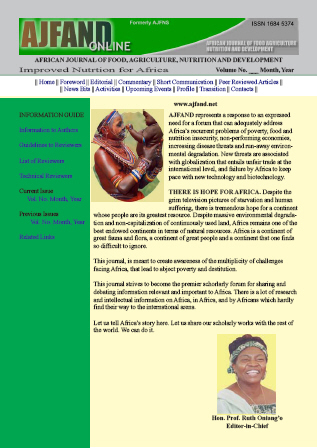
|
African Journal of Food, Agriculture, Nutrition and Development
Rural Outreach Program
ISSN: 1684-5358
EISSN: 1684-5358
Vol. 10, No. 4, 2010, pp. 2344-2357
|
 Bioline Code: nd10034
Bioline Code: nd10034
Full paper language: English
Document type: Research Article
Document available free of charge
|
|
|
African Journal of Food, Agriculture, Nutrition and Development, Vol. 10, No. 4, 2010, pp. 2344-2357
| en |
Expenditure Patterns On Food And Non-Food Items In HIV/AIDS Affected And Non-Affected Households In Kisumu District, Kenya
Agatha, C.O.; Walingo, M.A. & Othuon, L.
Abstract
The HIV/AIDS pandemic is a global crisis with consequences that will be felt for
decades to come. Though there are many chronic diseases in Kenya, HIV/AIDS is
presently having a devastating effect by threatening the food production systems,
intensifying poverty prevalence, increasing nutritional implications, creating more
orphans than existing social networks can cope with and basically affecting all
indicators of socioeconomic development in the country. Decreased productivity,
along with an increase in medical expenditures often results in a worsening livelihood
security situation for people living with HIV/AIDS and other members of their
households. The ability of households and communities to ensure their food and
nutrition security in the face of AIDS is being severely challenged. Livelihoods are
being eroded through the effects of premature illness and death on household labor
power and through the fracturing of intergenerational knowledge transfer. Social
relations and capacity to care are being put under immense strain by HIV-related
stigma and exclusion, increasing orphaning rates, and reduced incentives for
collective action. Financial stress is increased as expenditures for health care and
funerals increase, and as credit becomes harder to access. A cross-sectional study was
conducted to assess the expenditure patterns on food and non-food items of the
affected and non-affected households. Purposive sampling technique was used to
select 160 respondents. An interview schedule was used to collect the information.
Measures of central tendency as descriptive statistics and chi-square statistic as an
inferential statistic were used to analyse quantitative data. Data revealed that there is a
significant relationship between HIV/AIDS status and expenditure patterns on food
and non-food items. Most affected households had most productive persons affected
by HIV/AIDS. Thus, people living with HIV/AIDS, their families and communities
are overcome by the effects of the pandemic. It is recommended that the Ministries of
Health Planning and Development and Agriculture can save families from the effects
of HIV/AIDS by instituting food security interventions based on sound, sustainable
agricultural practices. The study will benefit the community, hospital, government and
non-governmental organizations (NGOs) through the findings which will help
improve the existing policies and programmes.
Keywords
Expenditure patterns, HIV, income, medication
|
| |
© Copyright 2010 - African Journal of Food Agriculture, Nutrition and Development.
Alternative site location: http://www.ajfand.net/
|
|
